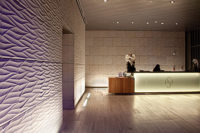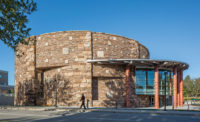
At the Veterinary Referral Center of North Texas in Dallas, TX, the design called for a very specific type of stone. The clinical nature of the building - coupled with the need for a welcoming feel for its customers - resulted in the selection of sandstone from India.
"We wanted to achieve a technical-type feel to the building - consistent with a referral medical practice - which also has an inviting, soft appearance for the people bringing in their animals," explained Architect Gary Beeman of Brinkley Sargent Architects. According to Beeman, this design goal turned out to be a difficult task, which required extensive research in choosing the proper stone. "We looked at several types of stone, using Stone World as a reference," said Beeman. "We also looked at buildings which used the same 8- x 8-inch modules and bricks that this building needed. From an aesthetic standpoint, we wanted a range in material, a textured look at different angles and a nice feel. Durability was needed as well."
After deciding the criteria for selection, the architects chose natural cleft Terra-Cotta sandstone, which was quarried in India and supplied by Amsum & Ash/TBA INDIA Inc. of Minneapolis, MN. "We wound up choosing this stone because it fit all our standards in an affordable manner," Beeman said. In addition to the sandstone, Riviera Beige limestone was used as an accent material.
The project required 23,000 square feet of the Terra-Cotta sandstone, which contrasted well with the Riviera Beige limestone that was used for the leg and accent band of the building.
Installation details
According to Beeman, the architects had hoped for tighter construction tolerances than what they had, but the installers, Alamo Tile Co. of Dallas, TX, still made the project a success.The exterior stonework was set using a thin-set mortar, and the tiles were set over a tile backerboard, explained Lee Copeland of the Alamo Tile Co. "We were going to adhere it to a mortar bed, but decided that the backerboard would be the best method for this particular project, and we have used this method before," he said. For longevity, the stone was then coated with a waterproofing product from Laticrete International.
Although Alamo Tile had employed this installation method before, it was not completed without some difficulty. "We had to work with 1-inch-thick slabs, which are hard to apply to the soffit. In order to overcome that problem, we used the mechanical method of hanging [the stone] with plaster and wire."
The stonework for the project took a total of nine weeks to complete, and the building was completed in November of 1999.

